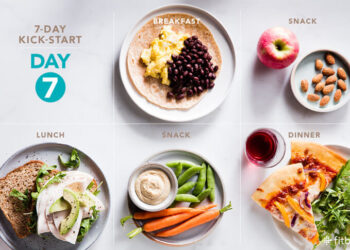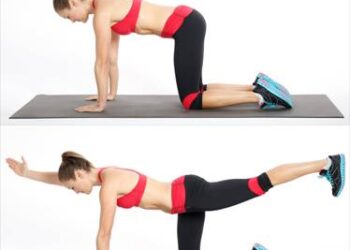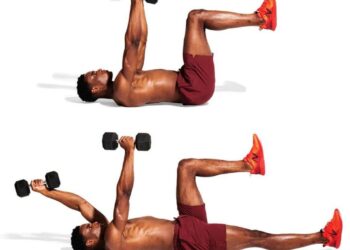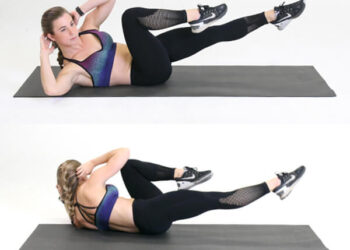
Staying active doesn’t require a gym membership or fancy equipment. Here are 15 effective and free workouts that you can easily do in the comfort of your home:
1. Bodyweight Exercises for a Full-Body Workout at Home
Bodyweight exercises offer a versatile and effective way to engage various muscle groups without the need for equipment. Here’s a comprehensive guide to several fundamental bodyweight exercises:
1.1 Push-Ups:
- Starting Position: Begin in a plank position with palms on the floor and hands slightly wider than shoulder-width apart.
- Execution: Lower your body by bending elbows until chest nearly touches the floor, then push back up.
- Muscles Targeted: Chest, shoulders, triceps, and core.
- Variations: Incline or decline push-ups, diamond push-ups, or staggered hand positions.
1.2 Squats:
- Starting Position: Stand with feet shoulder-width apart, toes slightly turned out.
- Execution: Lower hips by bending knees, keeping chest up and back straight, until thighs are parallel to the ground.
- Muscles Targeted: Quadriceps, hamstrings, glutes, and lower back.
- Variations: Jump squats, pistol squats, or sumo squats for variation.
1.3 Lunges:
- Starting Position: Stand with feet together, hands on hips.
- Execution: Step forward with one leg, lowering hips until both knees form 90-degree angles. Return to starting position.
- Muscles Targeted: Quadriceps, hamstrings, glutes, and calves.
- Variations: Reverse lunges, walking lunges, or jumping lunges for added intensity.
1.4 Plank:
- Starting Position: Support your body on forearms and toes, keeping a straight line from head to heels.
- Execution: Hold the position, engaging core muscles and maintaining a straight back.
- Muscles Targeted: Core muscles, including abdominals, obliques, and lower back.
- Variations: Side plank, plank with leg lifts, or plank rotations.
1.5 Burpees:
- Starting Position: Begin standing, then squat down and place hands on the floor in front of you.
- Execution: Kick feet back to a plank position, perform a push-up, jump feet back to hands, and explosively jump up.
- Muscles Targeted: Full-body workout, engaging chest, arms, legs, and core.
- Variations: Burpees with a jump at the top or without the push-up for modifications.
1.6 Mountain Climbers:
- Starting Position: Start in a plank position, hands under shoulders.
- Execution: Alternate bringing knees in towards the chest, one at a time, in a running motion.
- Muscles Targeted: Core muscles, shoulders, and legs.
- Variations: Cross-body mountain climbers or speed variations for added intensity.
1.7 Glute Bridge:
- Starting Position: Lie on your back with knees bent and feet flat on the floor.
- Execution: Lift hips off the ground, creating a straight line from shoulders to knees, and squeeze glutes at the top.
- Muscles Targeted: Glutes, lower back, and hamstrings.
- Variations: Single-leg glute bridges or weighted glute bridges for progression.

2. Cardiovascular Workouts: Boosting Heart Health and Endurance
Cardiovascular exercises are key to improving heart health, burning calories, and enhancing overall endurance. Here’s a detailed guide covering various effective cardio workouts you can perform at home:
2.1 Jumping Jacks:
- Execution: Start by standing with feet together and arms at sides. Jump while spreading legs and raising arms overhead simultaneously. Return to the starting position.
- Benefits: Elevates heart rate, works on coordination, and engages multiple muscle groups.
- Sets and Reps: Start with 3 sets of 30 seconds each, gradually increasing duration.
2.2 High Knees:
- Execution: Stand in place and jog while bringing knees as high as possible towards the chest alternatively.
- Benefits: Increases heart rate, strengthens lower body, and improves agility.
- Sets and Reps: Aim for 3 sets of 45 seconds each, maintaining a brisk pace.
2.3 Jump Rope:
- Execution: Use a jump rope and perform continuous jumps, landing softly on the balls of your feet.
- Benefits: Excellent for cardio, coordination, and enhancing footwork.
- Sets and Reps: Start with 3 sets of 1 minute each, gradually increasing duration.
2.4 Running in Place:
- Execution: Stand in place and run with high knees, moving arms in sync.
- Benefits: Elevates heart rate, mimics outdoor running, and improves lower body strength.
- Sets and Reps: Begin with 3 sets of 30 seconds each, progressing to longer durations.
2.5 Dancing:
- Execution: Follow dance workout routines or freestyle dance to upbeat music.
- Benefits: Offers a fun and effective way to boost cardiovascular endurance and mood.
- Sets and Reps: Dance for 20-30 minutes continuously for an effective session.
2.6 Stair Climbing:
- Execution: Utilize stairs at home, climbing up and down at a brisk pace.
- Benefits: Targets lower body muscles, enhances heart rate, and provides a challenging workout.
- Sets and Reps: Start with 3 sets of 1-2 minutes each, adding more sets gradually.
2.7 Cycling:
- Execution: Use a stationary bike or do cycling motions on the spot.
- Benefits: Improves cardiovascular fitness, strengthens legs, and is low-impact on joints.
- Sets and Reps: Start with 3 sets of 5 minutes each, gradually increasing duration.
2.8 Shadow Boxing:
- Execution: Perform boxing movements without equipment, throwing punches and footwork.
- Benefits: Enhances coordination, provides a full-body workout, and elevates heart rate.
- Sets and Reps: Engage in 3 sets of 1-2 minutes each, focusing on form and speed.
2.9 Circuit Training:
- Execution: Combine multiple cardio exercises in a circuit format, such as jumping jacks, high knees, and burpees.
- Benefits: Maximizes calorie burn, improves endurance, and offers variety in workouts.
- Sets and Reps: Perform each exercise for 30-60 seconds, repeating the circuit 3-4 times.
2.10 Box Jumps:
- Execution: Jump onto a stable surface like a box or step, ensuring a safe landing.
- Benefits: Boosts lower body strength, explosive power, and cardiovascular endurance.
- Sets and Reps: Begin with 3 sets of 8-10 jumps, gradually increasing height or repetitions.
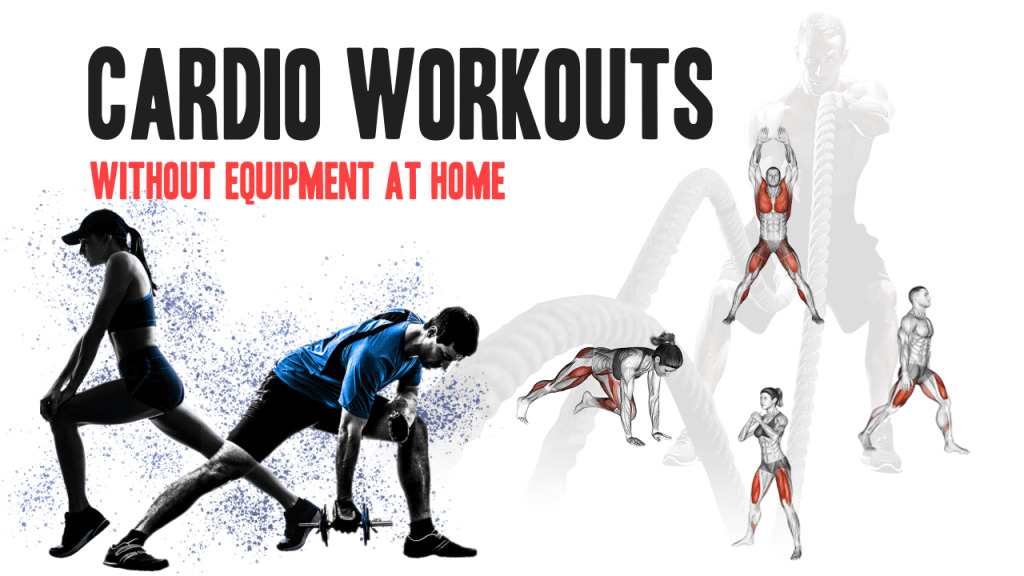
3. Yoga and Stretching: Enhancing Flexibility and Mindfulness
Yoga and stretching exercises are integral for improving flexibility, reducing stress, and promoting mindfulness. Here’s a detailed guide to incorporating these practices into your daily routine:
3.1 Sun Salutations (Surya Namaskar):
- Execution: Begin standing, inhale, raise arms overhead, exhale, bend forward, inhale, lengthen spine, exhale, step back to a plank, etc. Repeat the sequence.
- Benefits: Warms up the body, improves flexibility, and provides a full-body stretch.
- Repetitions: Start with 5 rounds, gradually increasing to 10 or more.
3.2 Downward Facing Dog (Adho Mukha Svanasana):
- Execution: Start on hands and knees, lift hips up and back, straighten arms and legs, creating an inverted V-shape.
- Benefits: Stretches hamstrings, calves, and shoulders while relieving tension in the spine.
- Duration: Hold for 30-60 seconds, breathing deeply.
3.3 Seated Forward Fold (Paschimottanasana):
- Execution: Sit with legs extended, inhale, lengthen spine, exhale, hinge at hips, reaching for feet or shins.
- Benefits: Stretches hamstrings and lower back, calms the mind, and stimulates the digestive system.
- Duration: Hold for 30-60 seconds, gently increasing stretch.
3.4 Cat-Cow Stretch (Marjaryasana-Bitilasana):
- Execution: Start on hands and knees, arch your back up towards the ceiling (cat pose), then drop the belly and lift the head (cow pose).
- Benefits: Improves spinal flexibility, massages internal organs, and enhances coordination.
- Repetitions: Perform 10 rounds, coordinating with breath.
3.5 Standing Forward Bend (Uttanasana):
- Execution: Stand with feet hip-width apart, fold forward from the hips, reaching towards the floor or shins.
- Benefits: Stretches hamstrings, calves, and back muscles, while calming the mind.
- Duration: Hold for 30-60 seconds, focusing on relaxing into the stretch.
3.6 Child’s Pose (Balasana):
- Execution: Kneel on the floor, sit back on heels, bend forward, extending arms in front or alongside the body.
- Benefits: Stretches the spine, hips, and thighs, while promoting relaxation and relieving stress.
- Duration: Hold for 1-2 minutes, breathing deeply and relaxing.
3.7 Pigeon Pose (Eka Pada Rajakapotasana):
- Execution: From a downward dog, bring one knee forward towards the wrist, extending the other leg behind, and lower the hips towards the ground.
- Benefits: Opens hips, stretches glutes, and releases tension in the lower back and hip flexors.
- Duration: Hold for 30-60 seconds per side, easing into the stretch gradually.
3.8 Butterfly Stretch (Baddha Konasana):
- Execution: Sit with feet together, knees bent, and gently press thighs towards the floor, holding feet.
- Benefits: Stretches inner thighs and groin muscles, promotes hip flexibility, and eases lower back tension.
- Duration: Hold for 30-60 seconds, gently increasing the stretch over time.
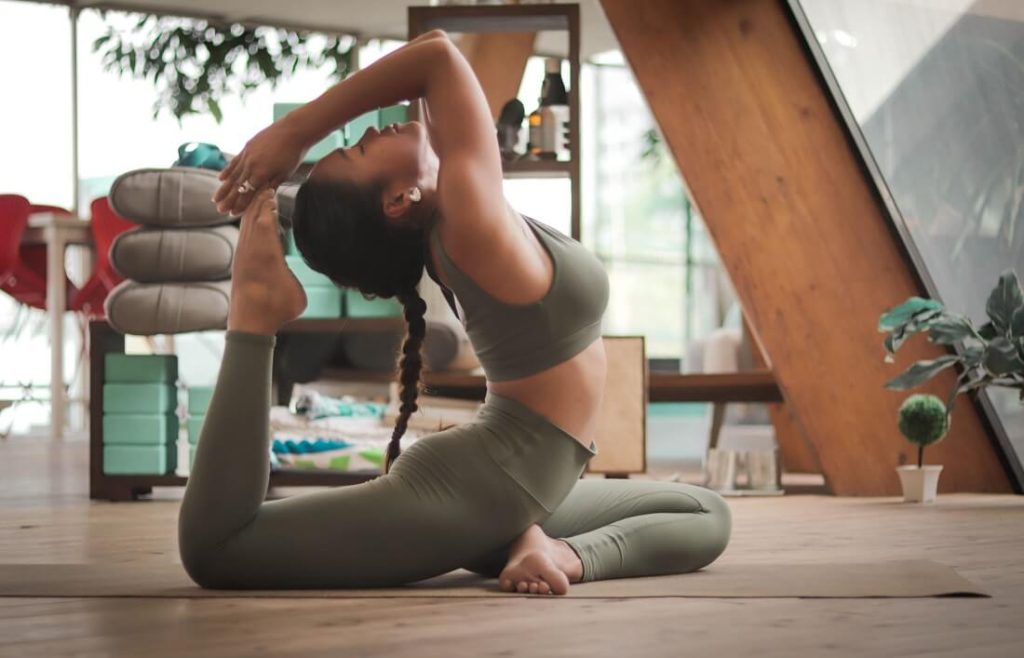
4. Pilates Moves for Core Strength and Stability
Pilates exercises are renowned for targeting core muscles, enhancing stability, and improving overall body strength. Here’s a detailed guide to several effective Pilates moves:
4.1 The Hundred:
- Execution: Lie on your back, lift legs off the floor, and engage core. Pump arms up and down while breathing in for five counts and out for five counts.
- Benefits: Strengthens abdominals, improves breathing, and increases blood circulation.
- Repetitions: Aim for 10 cycles (100 arm pumps in total).
4.2 Roll-Up:
- Execution: Lie flat, extend arms overhead, exhale and articulate your spine off the mat, reaching for toes. Inhale to roll back down.
- Benefits: Strengthens core muscles, improves spinal flexibility, and enhances posture.
- Repetitions: Perform 8-10 repetitions with controlled movements.
4.3 Single Leg Stretch:
- Execution: Lie on your back, lift head and shoulders, hug one knee towards chest while extending the other leg straight. Switch legs.
- Benefits: Engages abdominals, improves hip flexor flexibility, and stabilizes the core.
- Repetitions: Aim for 10-12 repetitions on each leg.
4.4 Double Leg Stretch:
- Execution: Lie on your back, bring knees towards chest, lift head and shoulders, extend arms and legs out. Circle arms around as you bring legs back in.
- Benefits: Strengthens core, challenges stability, and enhances coordination.
- Repetitions: Perform 8-10 controlled movements.
4.5 Plank Variations:
- Execution: Hold a plank position on forearms or hands, ensuring a straight line from head to heels. Try side plank or plank with leg lifts for variations.
- Benefits: Engages core, strengthens shoulders, and improves overall stability.
- Duration: Hold for 30-60 seconds per variation, gradually increasing time.
4.6 Scissor Kick:
- Execution: Lie on your back, lift legs off the floor, scissor legs up and down while engaging abdominals.
- Benefits: Targets lower abdominals, enhances leg strength, and improves hip flexibility.
- Repetitions: Aim for 10-12 scissor kicks on each leg.
4.7 Swan Dive:
- Execution: Lie on stomach, place hands under shoulders, lift upper body and legs off the floor, lengthening spine.
- Benefits: Strengthens back muscles, stretches front body, and improves posture.
- Repetitions: Perform 6-8 repetitions with control.
4.8 Teaser:
- Execution: Sit tall, legs extended, roll spine down and back up while lifting legs into a V position.
- Benefits: Challenges core strength, improves balance, and enhances spinal mobility.
- Repetitions: Start with 5-6 repetitions, focusing on controlled movements.
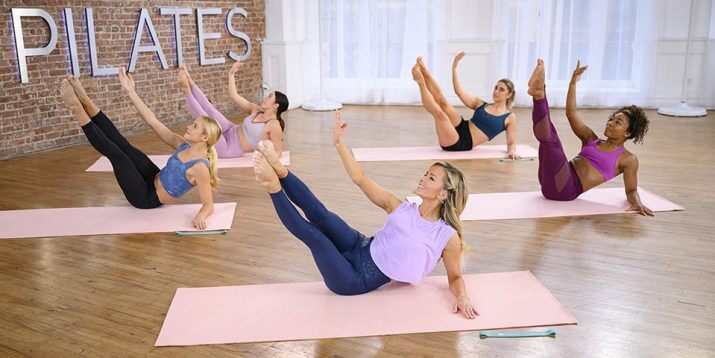
5. HIIT (High-Intensity Interval Training): Maximizing Calorie Burn and Fitness Gains
HIIT is an effective workout method involving short bursts of intense exercises followed by brief rest or low-intensity periods. Here’s a detailed guide to some HIIT exercises:
5.1 Burpees:
- Execution: Start standing, drop into a squat position, place hands on the floor, kick feet back into a plank, perform a push-up, jump feet back to hands, explosively jump up.
- Benefits: Full-body workout, enhances cardiovascular fitness, and boosts metabolism.
- Timing: Perform 20-30 seconds of burpees followed by 10-20 seconds of rest.
5.2 Jump Squats:
- Execution: Begin with a squat, explosively jump up, extending legs fully. Land softly, returning to the squat position.
- Benefits: Works lower body muscles, enhances power, and elevates heart rate.
- Timing: Perform 20-30 seconds of jump squats, followed by 10-20 seconds of rest.
5.3 High Knees:
- Execution: Run in place, bringing knees up as high as possible towards the chest, pumping arms for momentum.
- Benefits: Increases heart rate, works lower body muscles, and improves coordination.
- Timing: Perform 30-40 seconds of high knees, followed by 10-20 seconds of rest.
5.4 Mountain Climbers:
- Execution: Start in a plank position, alternate bringing knees in towards the chest in a running motion.
- Benefits: Engages core muscles, elevates heart rate, and provides a full-body workout.
- Timing: Perform 30-40 seconds of mountain climbers, followed by 10-20 seconds of rest.
5.5 Jumping Lunges:
- Execution: Start with a lunge position, explosively jump up and switch legs mid-air, landing in a lunge on the other side.
- Benefits: Targets legs and glutes, enhances explosiveness, and increases heart rate.
- Timing: Perform 20-30 seconds of jumping lunges, followed by 10-20 seconds of rest.
5.6 Plank Jacks:
- Execution: Begin in a plank position, jump feet wide and then back together while maintaining the plank.
- Benefits: Engages core, works on cardiovascular endurance, and challenges stability.
- Timing: Perform 30-40 seconds of plank jacks, followed by 10-20 seconds of rest.
5.7 Sprint Intervals:
- Execution: Sprint at maximum effort for a short distance or time, followed by a brief recovery period at a slower pace or rest.
- Benefits: Improves speed, boosts cardiovascular fitness, and burns calories effectively.
- Timing: Sprint for 20-30 seconds, followed by 40-60 seconds of recovery.
5.8 Bicycle Crunches:
- Execution: Lie on your back, bring knees towards chest, perform a cycling motion with legs, touching opposite elbow to opposite knee.
- Benefits: Engages core muscles, works on abdominal strength, and enhances oblique muscles.
- Timing: Perform 30-40 seconds of bicycle crunches, followed by 10-20 seconds of rest.
Note: HIIT requires careful consideration and proper technique to avoid injuries. Before starting any HIIT program, ensure it suits your fitness level and seek advice from a professional if necessary.
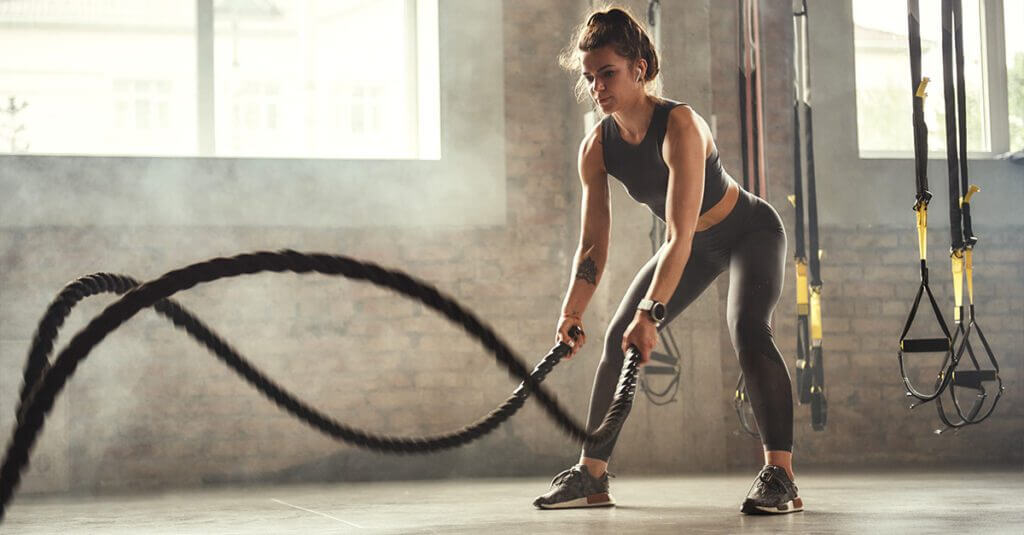
6. Dance Workouts: Fun and Energetic Fitness Routines
Dance workouts offer a dynamic and enjoyable way to stay fit, combining movements with music. Here’s a detailed guide to various dance workout styles you can try:
6.1 Zumba:
- Description: Zumba incorporates Latin and international music with dance movements, focusing on cardio and rhythm.
- Benefits: Burns calories, improves coordination, and enhances cardiovascular health.
- Tips: Follow along with Zumba classes online or at a fitness studio for structured routines.
6.2 Hip-Hop Dance:
- Description: Hip-hop dance involves urban dance styles set to hip-hop music, emphasizing rhythm and expression.
- Benefits: Boosts agility, builds strength, and allows self-expression through movement.
- Tips: Join hip-hop dance classes or watch tutorials to learn popular choreographies.
6.3 Bollywood Dance:
- Description: Bollywood dance incorporates Indian dance styles with upbeat music from Bollywood films, emphasizing energetic movements and storytelling.
- Benefits: Increases flexibility, boosts energy levels, and promotes cultural appreciation.
- Tips: Explore online tutorials or local classes to learn Bollywood dance steps.
6.4 Ballet Fitness:
- Description: Ballet fitness workouts blend traditional ballet techniques with fitness exercises, focusing on grace, balance, and strength.
- Benefits: Enhances posture, tones muscles, and improves flexibility.
- Tips: Follow ballet-inspired workouts online or consider joining a beginner’s ballet fitness class.
6.5 Jazzercise:
- Description: Jazzercise combines jazz dance, resistance training, Pilates, yoga, and cardio exercises set to upbeat music.
- Benefits: Burns calories, improves endurance, and tones the body.
- Tips: Join a Jazzercise class or follow online routines for a full-body workout.
6.6 Salsa Dance:
- Description: Salsa dance originates from Latin America, featuring lively movements and rhythmic footwork set to salsa music.
- Benefits: Enhances coordination, burns calories, and uplifts mood.
- Tips: Attend salsa dance classes or follow instructional videos to learn basic steps and partner work.
6.7 Afrobeat Dance:
- Description: Afrobeat dance incorporates African dance styles with modern influences, characterized by energetic movements and vibrant music.
- Benefits: Improves cardiovascular health, strengthens muscles, and boosts confidence.
- Tips: Join Afrobeat dance classes or follow tutorials to learn the energetic choreography.
6.8 Contemporary Dance:
- Description: Contemporary dance combines elements from different dance styles, emphasizing self-expression and fluid movements.
- Benefits: Enhances creativity, flexibility, and emotional expression through dance.
- Tips: Explore online classes or workshops to learn contemporary dance techniques.
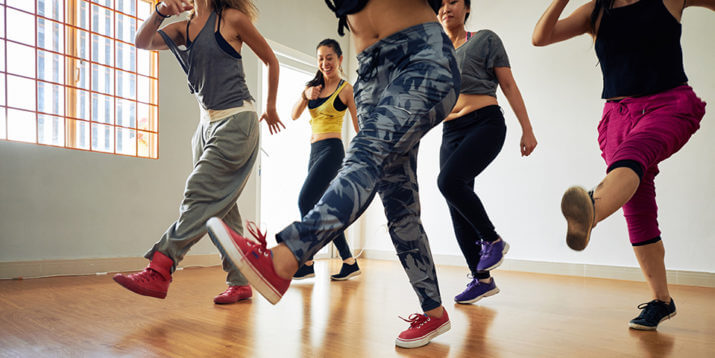
7. Resistance Band Exercises: Enhancing Strength and Flexibility
Resistance band exercises offer a versatile and portable way to build muscle strength and improve flexibility. Here’s a detailed guide to various exercises using resistance bands:
7.1 Bicep Curls:
- Execution: Stand on the resistance band, hold handles or ends, and curl arms up towards shoulders while keeping elbows stationary.
- Benefits: Targets biceps, strengthens arm muscles, and improves grip strength.
- Repetitions: Perform 12-15 curls for 2-3 sets.
7.2 Lat Pulldowns:
- Execution: Anchor the band overhead, hold handles, and pull elbows down towards sides, squeezing shoulder blades together.
- Benefits: Works on back muscles, improves posture, and enhances upper body strength.
- Repetitions: Aim for 10-12 reps for 2-3 sets.
7.3 Standing Rows:
- Execution: Step on the band, hold handles, and pull elbows back, squeezing shoulder blades together, as if rowing.
- Benefits: Targets upper back muscles, enhances posture, and strengthens shoulders.
- Repetitions: Perform 12-15 rows for 2-3 sets.
7.4 Chest Press:
- Execution: Secure band behind back, hold handles, and press arms forward at chest level, squeezing chest muscles.
- Benefits: Strengthens chest muscles, mimics the chest press machine, and improves upper body strength.
- Repetitions: Aim for 10-12 presses for 2-3 sets.
7.5 Leg Press:
- Execution: Anchor band behind you, loop around one foot, extend leg forward against resistance.
- Benefits: Targets quadriceps, enhances leg strength, and complements lower body workouts.
- Repetitions: Perform 12-15 presses on each leg for 2-3 sets.
7.6 Glute Bridges:
- Execution: Lie on your back, place band around hips, lift hips up while squeezing glutes, keeping tension in the band.
- Benefits: Works on glute muscles, improves hip stability, and strengthens lower back.
- Repetitions: Aim for 15-20 bridges for 2-3 sets.
7.7 Lateral Band Walks:
- Execution: Place band around ankles, assume a half-squat position, and step sideways while maintaining tension in the band.
- Benefits: Targets hip abductor muscles, enhances hip stability, and aids in injury prevention.
- Repetitions: Perform 10-12 steps in each direction for 2-3 sets.
7.8 Tricep Extensions:
- Execution: Hold one end of the band, extend arm overhead, and bend elbow, lowering hand behind head.
- Benefits: Engages triceps, improves arm strength, and tones upper arms.
- Repetitions: Perform 12-15 extensions on each arm for 2-3 sets.
Remember, when using resistance bands in workouts, it’s important to pay attention to technique, maintain tension, and adjust intensity to prevent injuries. Consistently performing these exercises helps improve overall body strength and flexibility.
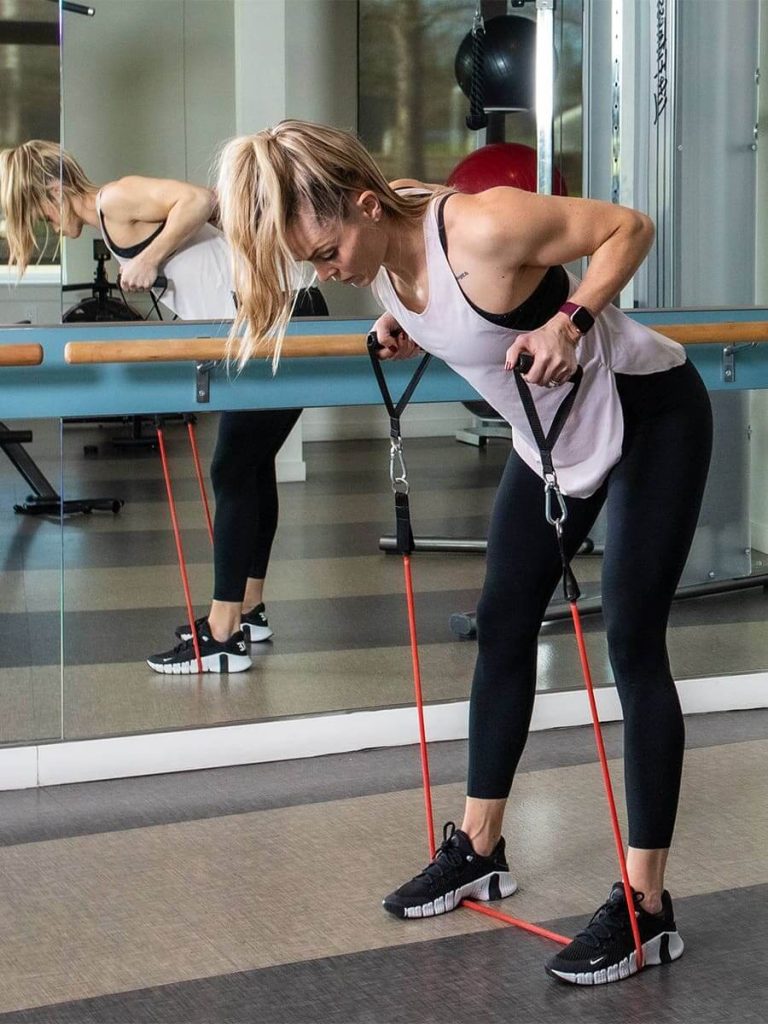
8. Skipping or Jump Rope: A Versatile Cardio Workout
Skipping or jump rope exercises are fantastic for cardiovascular health and enhancing agility. Here’s a detailed guide to mastering jump rope workouts:
8.1 Choosing the Right Rope:
- Type: Select a suitable jump rope—adjustable length, comfortable handles, and appropriate weight for your fitness level.
- Size: Stand on the middle of the rope, handles should reach armpits when pulled up.
- Material: Nylon ropes are durable; speed ropes offer quicker rotations.
8.2 Proper Technique:
- Posture: Stand tall, engage core, shoulders relaxed, elbows close to the body, and wrists controlling the rope.
- Footwork: Land softly on the balls of the feet, knees slightly bent, and maintain a consistent rhythm.
- Arm Movement: Rotate the rope using wrists, keeping elbows close to the sides.
8.3 Basic Jump Rope Techniques:
- Two-Foot Basic Jump: Start with both feet together, jump over the rope as it passes beneath.
- Alternate Foot Jump: Alternate jumping each foot over the rope individually.
- High Knees: Lift knees higher while jumping rope for a more intense workout.
8.4 Jump Rope Workouts:
- Interval Training: Incorporate intervals of intense skipping followed by slower-paced jumping or rest.
- Tabata Style: Perform 20 seconds of high-intensity jumping followed by 10 seconds of rest, repeated for 4 minutes.
- Double-Unders: Swing the rope twice under your feet with each jump for an advanced move.
- Cross-Overs: Cross arms while jumping for a challenging variation.
8.5 Benefits of Jump Rope:
- Cardiovascular Fitness: Improves heart health and endurance with consistent jumping routines.
- Calorie Burning: Burns calories effectively, aiding in weight loss and toning muscles.
- Enhanced Coordination: Improves footwork, agility, and overall coordination.
- Portable Workout: Easy to carry, allowing workouts virtually anywhere.
8.6 Safety Tips:
- Surface: Choose a flat, non-slip surface to jump on, preventing accidents.
- Proper Footwear: Wear cushioned, supportive shoes to reduce impact on joints.
- Start Slowly: Begin with shorter sessions and gradually increase duration as endurance builds.
8.7 Incorporating Variations:
- Adding Challenges: Increase speed, try complex footwork, or incorporate other exercises between jumps.
- Rope Length Changes: Experiment with longer or shorter ropes to vary intensity and challenge.
8.8 Cool Down and Stretch:
- Cool Down: End the session with slow-paced jumping or walking to gradually lower heart rate.
- Stretching: Perform calf stretches, hamstring stretches, and shoulder rolls to relax muscles.
Jumping rope is not just an excellent cardio exercise but also a versatile and enjoyable workout method. Consistent practice will enhance cardiovascular health, effectively burn calories, and improve flexibility and endurance of the body.

9. Chair Workouts: Utilizing a Chair for Effective Exercises
Chair workouts provide a convenient way to engage various muscle groups using a simple piece of furniture. Here’s a guide to chair exercises you can incorporate into your routine:
9.1 Seated Leg Lifts:
- Execution: Sit upright, hands gripping the sides of the chair, extend legs straight out, then lift and hold legs in the air.
- Benefits: Targets lower abs, quads, and improves leg strength.
- Repetitions: Aim for 12-15 lifts for 2-3 sets.
9.2 Tricep Dips:
- Execution: Sit at the edge of the chair, grip the sides, slide off the chair, bend elbows to lower body, then push back up.
- Benefits: Works triceps, enhances arm strength, and helps tone upper arms.
- Repetitions: Perform 10-12 dips for 2-3 sets.
9.3 Seated March:
- Execution: Sit tall, lift one knee up towards the chest, then alternate legs, mimicking a marching motion.
- Benefits: Engages core muscles, improves balance, and boosts circulation.
- Repetitions: Do 20-30 marches for 2-3 sets.
9.4 Seated Russian Twists:
- Execution: Sit on the chair’s edge, lean back slightly, twist torso to one side, then the other, touching the chair’s sides.
- Benefits: Targets obliques, improves core stability, and enhances rotational strength.
- Repetitions: Perform 12-15 twists on each side for 2-3 sets.
9.5 Chair Squats:
- Execution: Stand in front of the chair, bend knees, lower body down as if sitting, lightly tap the chair, then stand back up.
- Benefits: Works quads, hamstrings, and glutes, improving lower body strength.
- Repetitions: Aim for 15-20 squats for 2-3 sets.
9.6 Seated Shoulder Press:
- Execution: Hold weights or use resistance bands, sit tall, press arms upward, extending them fully above the head.
- Benefits: Targets shoulder muscles, strengthens deltoids, and improves upper body strength.
- Repetitions: Perform 10-12 presses for 2-3 sets.
9.7 Seated Knee Extensions:
- Execution: Sit upright, feet flat on the floor, extend one leg straight out, hold briefly, then switch legs.
- Benefits: Engages quadriceps, improves leg strength, and aids knee stability.
- Repetitions: Do 15-20 extensions on each leg for 2-3 sets.
9.8 Chair Yoga Poses:
- Execution: Utilize the chair for modified yoga poses like seated twists, forward bends, or modified pigeon stretches.
- Benefits: Enhances flexibility, promotes relaxation, and improves posture.
- Repetitions: Hold each pose for 30-60 seconds, repeating for 2-3 sets.
Remember, chair exercises are an effective way to work out without the need for expensive equipment or large spaces. Utilize the chair as a versatile tool to enhance overall health and physical strength.
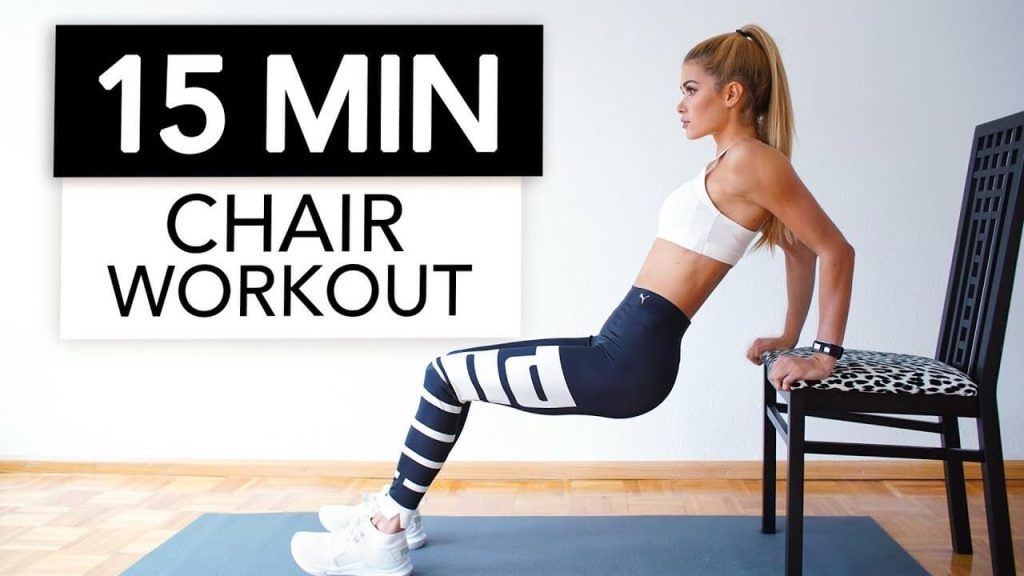
10. Staircase Exercises: Utilizing Stairs for Effective Workouts
Staircase exercises offer a practical way to incorporate fitness into your daily routine using a readily available structure. Here’s a guide to stair workouts that can boost your fitness level:
10.1 Stair Climbing:
- Execution: Ascend and descend stairs repeatedly at a brisk pace.
- Benefits: Engages leg muscles, enhances cardiovascular endurance, and burns calories.
- Repetitions: Aim for 10-15 minutes of stair climbing.
10.2 Stair Step-Ups:
- Execution: Stand in front of the bottom step, step up with one foot, then bring the other foot up, and step back down.
- Benefits: Works quadriceps, hamstrings, and glutes, improving lower body strength.
- Repetitions: Perform 10-12 step-ups on each leg for 2-3 sets.
10.3 Stair Lunges:
- Execution: Step one foot onto a higher step, lower back knee towards the ground, then push back up.
- Benefits: Targets quadriceps, hamstrings, and glutes, enhancing lower body strength.
- Repetitions: Do 12-15 lunges on each leg for 2-3 sets.
10.4 Calf Raises:
- Execution: Stand on the edge of a step, raise heels up, then lower them below the step to stretch calves.
- Benefits: Strengthens calf muscles, improves ankle stability, and aids in balance.
- Repetitions: Perform 15-20 calf raises for 2-3 sets.
10.5 Stair Sprints:
- Execution: Run up the stairs as fast as possible, then walk back down to recover.
- Benefits: Boosts cardiovascular fitness, improves agility, and burns calories effectively.
- Repetitions: Sprint up the stairs 5-8 times.
10.6 Stair Side Steps:
- Execution: Step sideways up the stairs, leading with one foot, then return to the starting position.
- Benefits: Engages inner and outer thigh muscles, improving leg strength and stability.
- Repetitions: Perform 10-12 side steps on each side for 2-3 sets.
10.7 Stair Jumps:
- Execution: Jump explosively up the stairs, landing softly with both feet on the next step, then continue.
- Benefits: Enhances explosive power, works lower body muscles, and improves coordination.
- Repetitions: Do 8-10 jumps for 2-3 sets.
10.8 Staircase Planks:
- Execution: Assume a plank position with hands on a step, hold the position while maintaining a straight line from head to heels.
- Benefits: Strengthens core muscles, improves stability, and works upper body.
- Duration: Hold the plank for 30-60 seconds for 2-3 sets.
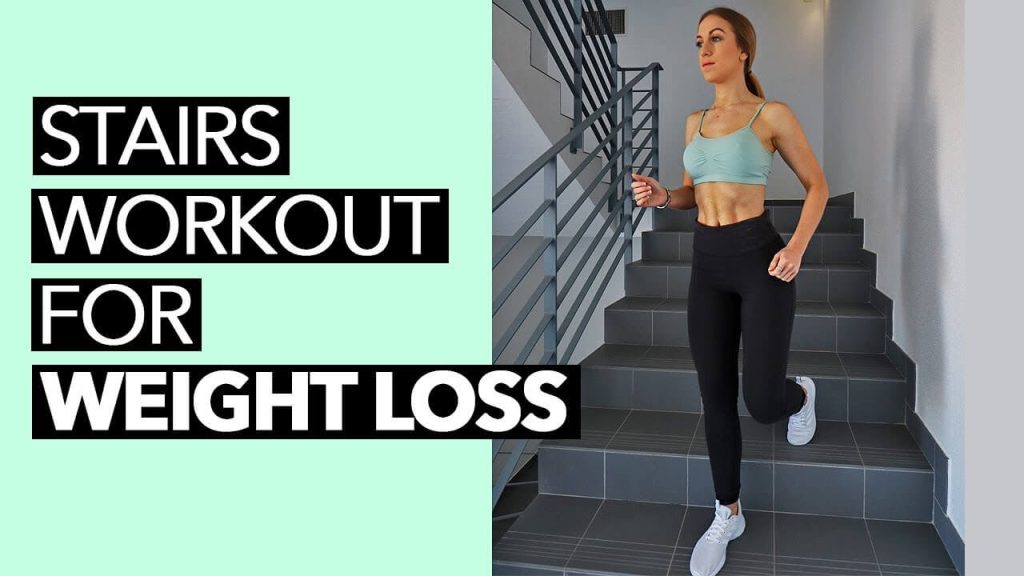
11. Home Circuit Training: A Comprehensive Workout Routine
Home circuit training involves performing a series of exercises in succession with minimal rest, targeting different muscle groups and enhancing overall fitness. Here’s a guide to a home circuit training routine:
11.1 Warm-Up:
- Jumping Jacks: 1 minute
- Arm Circles: 30 seconds forward, 30 seconds backward
- Bodyweight Squats: 1 set of 15-20 reps
11.2 Circuit Exercises:
Circuit 1 – Lower Body:
- Bodyweight Squats: 15 reps
- Lunges (alternating legs): 12 reps per leg
- Glute Bridges: 15 reps
- Rest: 1 minute
Circuit 2 – Upper Body:
- Push-Ups: 12-15 reps
- Chair Dips: 12-15 reps
- Bent-Over Rows (using resistance bands or weights): 12-15 reps
- Rest: 1 minute
Circuit 3 – Core:
- Plank: Hold for 30-60 seconds
- Russian Twists: 15 reps per side
- Bicycle Crunches: 15 reps per side
- Rest: 1 minute
Circuit 4 – Cardio Bursts:
- Jumping Rope: 1 minute
- High Knees: 1 minute
- Mountain Climbers: 1 minute
- Rest: 1 minute
11.3 Cool Down:
- Walking in Place: 2 minutes
- Full-Body Stretches: 5-10 minutes (include stretches for legs, arms, back, and shoulders)
Tips for Effective Circuit Training:
- Maintain Form: Focus on proper technique during exercises to prevent injuries and maximize benefits.
- Adjust Intensity: Modify exercises or increase/decrease reps based on fitness levels.
- Rest Intervals: Stick to the specified rest times between circuits to keep the workout challenging.
- Stay Hydrated: Drink water before, during, and after the workout to stay hydrated.
- Listen to Your Body: If any exercise causes discomfort, modify or skip it.
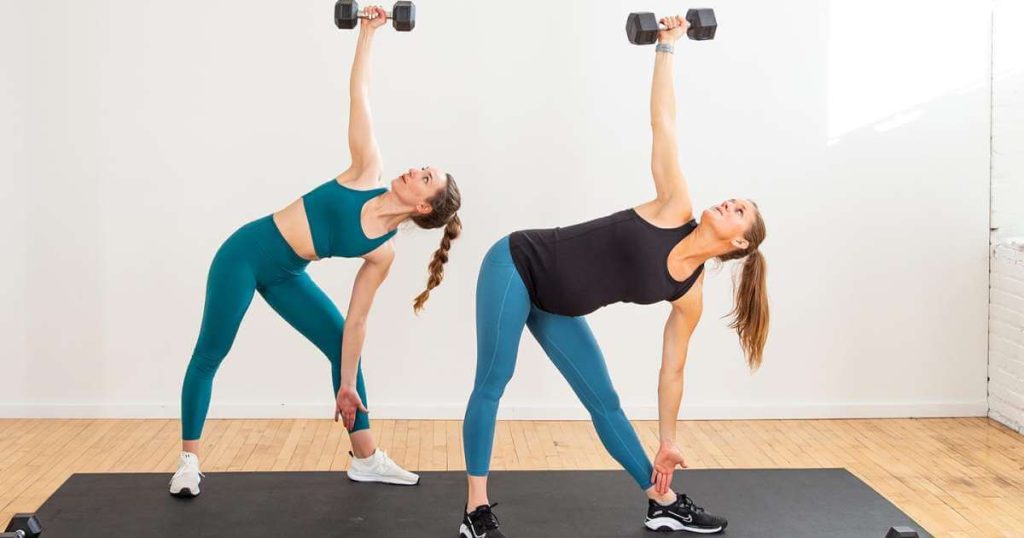
12. Balance and Stability Work: Enhancing Core Strength and Coordination
Improving balance and stability is crucial for overall fitness and injury prevention. Here’s a guide to exercises that focus on enhancing these aspects:
12.1 One-Leg Stands:
- Execution: Stand on one leg, lift the other leg slightly off the ground, maintain balance for 30 seconds, then switch legs.
- Benefits: Improves ankle stability, strengthens leg muscles, and enhances focus.
- Repetitions: Perform 3-4 sets on each leg.
12.2 Heel-to-Toe Walk:
- Execution: Walk in a straight line placing the heel of one foot directly in front of the toes of the other foot.
- Benefits: Enhances proprioception, strengthens calf muscles, and improves coordination.
- Duration: Walk for 1-2 minutes.
12.3 Stability Ball Exercises:
- Ball Squats: Stand against a wall, place a stability ball between your back and the wall, perform squats while keeping the ball in place.
- Benefits: Strengthens leg muscles, improves balance, and engages core stabilizers.
- Repetitions: Aim for 12-15 squats for 2-3 sets.
12.4 Bosu Ball Balancing:
- Standing on Bosu: Stand on the flat side of a Bosu ball, try to balance for 30-60 seconds without losing stability.
- Benefits: Enhances core strength, improves proprioception, and challenges stability.
- Repetitions: Perform 3-4 sets.
12.5 Yoga and Tai Chi:
- Yoga Poses: Incorporate yoga poses like Tree Pose, Warrior III, and Half Moon for balance improvement.
- Tai Chi Movements: Practice slow, deliberate movements to improve balance and stability.
- Duration: Hold yoga poses for 30-60 seconds, practice Tai Chi for 10-15 minutes.
12.6 Single Leg Deadlifts:
- Execution: Stand on one leg, hinge at the hips, lower the torso while raising the other leg behind, then return to the starting position.
- Benefits: Strengthens hamstrings, glutes, and lower back while improving balance.
- Repetitions: Perform 10-12 reps on each leg for 2-3 sets.
12.7 Wobble Board Exercises:
- Using a Wobble Board: Stand on the wobble board and try to maintain balance as the board shifts.
- Benefits: Enhances ankle stability, works on core muscles, and improves overall stability.
- Repetitions: Try balancing for 1-2 minutes for 3-4 sets.
12.8 Safety Tips:
- Use Support: Start exercises near a wall or stable surface for support.
- Progress Gradually: Begin with easier exercises and gradually increase difficulty.
- Focus on Form: Pay attention to proper posture and form during exercises to prevent injury.
- Stay Consistent: Practice these exercises regularly to see improvements in balance and stability.

13. Core Strengthening: Building a Stronger Core for Better Stability
A strong core is fundamental for stability, posture, and overall strength. Here’s a guide to various core exercises you can incorporate into your routine:
13.1 Plank Variations:
- Traditional Plank: Support your body on your forearms and toes, keeping a straight line from head to heels.
- Side Plank: Support your body on one forearm and the side of your foot, keeping your body straight.
- Plank with Leg Lifts: Lift one leg off the ground while maintaining the plank position.
- Repetitions: Hold each variation for 30-60 seconds.
13.2 Crunches and Sit-Ups:
- Basic Crunches: Lie on your back, knees bent, hands behind your head, lift your shoulders towards your knees.
- Reverse Crunches: Lie on your back, knees bent, lift your hips off the ground towards your chest.
- Sit-Ups: Perform full sit-ups, lifting your torso off the ground towards your knees.
- Repetitions: Aim for 15-20 reps for each variation.
13.3 Russian Twists:
- Execution: Sit on the floor, lean back slightly, rotate your torso from side to side while holding a weight or medicine ball.
- Benefits: Targets obliques, improves rotational stability, and enhances core strength.
- Repetitions: Perform 12-15 twists on each side.
13.4 Bicycle Crunches:
- Execution: Lie on your back, hands behind your head, bring one elbow towards the opposite knee while extending the other leg.
- Benefits: Engages rectus abdominis and obliques, improving core strength and flexibility.
- Repetitions: Do 15-20 reps per side.
13.5 Superman Exercise:
- Execution: Lie face down, extend arms and legs, lift arms, chest, and legs off the ground, then lower back down.
- Benefits: Strengthens lower back muscles, improves posture, and engages the entire core.
- Repetitions: Perform 12-15 reps.
13.6 Mountain Climbers:
- Execution: Start in a plank position, bring one knee towards the chest, then switch legs in a running motion.
- Benefits: Engages core muscles, improves cardiovascular endurance, and enhances agility.
- Repetitions: Aim for 30-45 seconds of continuous movement.
13.7 Tips for Effective Core Training:
- Consistency: Include core exercises in your routine at least 2-3 times per week.
- Proper Form: Focus on maintaining proper form to maximize effectiveness and prevent injury.
- Variety: Incorporate different exercises to target all areas of the core for comprehensive strength.
- Progression: Gradually increase the intensity or reps as your core strength improves.

14. Meditation and Breathing Exercises: Relaxation Techniques for Mind and Body
Meditation and controlled breathing exercises can significantly reduce stress, improve focus, and promote relaxation. Here’s a guide to incorporate these practices into your routine:
14.1 Mindfulness Meditation:
- Sit Comfortably: Find a quiet spot, sit comfortably with a straight back, and relax your shoulders.
- Focus on Breathing: Inhale and exhale naturally, directing attention to the sensation of your breath.
- Mindful Observation: Acknowledge thoughts and sensations without judgment, gently guiding focus back to the breath.
- Duration: Start with 5-10 minutes and gradually increase to longer sessions.
14.2 Diaphragmatic Breathing (Belly Breathing):
- Lie Down or Sit Comfortably: Place one hand on your chest and the other on your abdomen.
- Breathe Deeply: Inhale through your nose, let your abdomen rise as you breathe deeply, then exhale slowly.
- Focus on Breath Movement: Ensure chest remains still while your abdomen expands and contracts.
- Repetitions: Practice for 5-10 minutes.
14.3 Box Breathing Technique:
- Inhale: Slowly breathe in through your nose for a count of four.
- Hold: Hold your breath for a count of four.
- Exhale: Slowly exhale through your mouth for a count of four.
- Pause: Hold your breath for a count of four before beginning the next cycle.
- Repetitions: Complete 4-5 cycles.
14.4 Guided Imagery Meditation:
- Relaxation: Sit comfortably and close your eyes. Visualize a peaceful scene or place that brings relaxation.
- Engage Senses: Imagine detailed aspects of the scene – sights, sounds, smells, and sensations.
- Focus on Relaxation: Breathe deeply and allow yourself to become immersed in the calming imagery.
- Duration: Follow guided imagery sessions for 10-15 minutes.
14.5 Progressive Muscle Relaxation:
- Lie Down or Sit Comfortably: Start with your feet and systematically tense and relax each muscle group as you work up your body.
- Focus on Relaxation: Inhale as you tense the muscles, then exhale and release the tension.
- Repetitions: Work through all major muscle groups, spending 5-10 seconds on each.
14.6 Tips for Effective Practice:
- Consistency: Dedicate regular time slots for meditation and breathing exercises.
- Quiet Environment: Find a quiet, comfortable space for relaxation without distractions.
- Comfortable Position: Sit or lie down in a position that feels relaxed and promotes focus.
- Deep Breathing: Focus on slow, deep breaths to facilitate relaxation and calmness.
- Guided Sessions: Utilize guided meditation or breathing apps if needed for structured sessions.
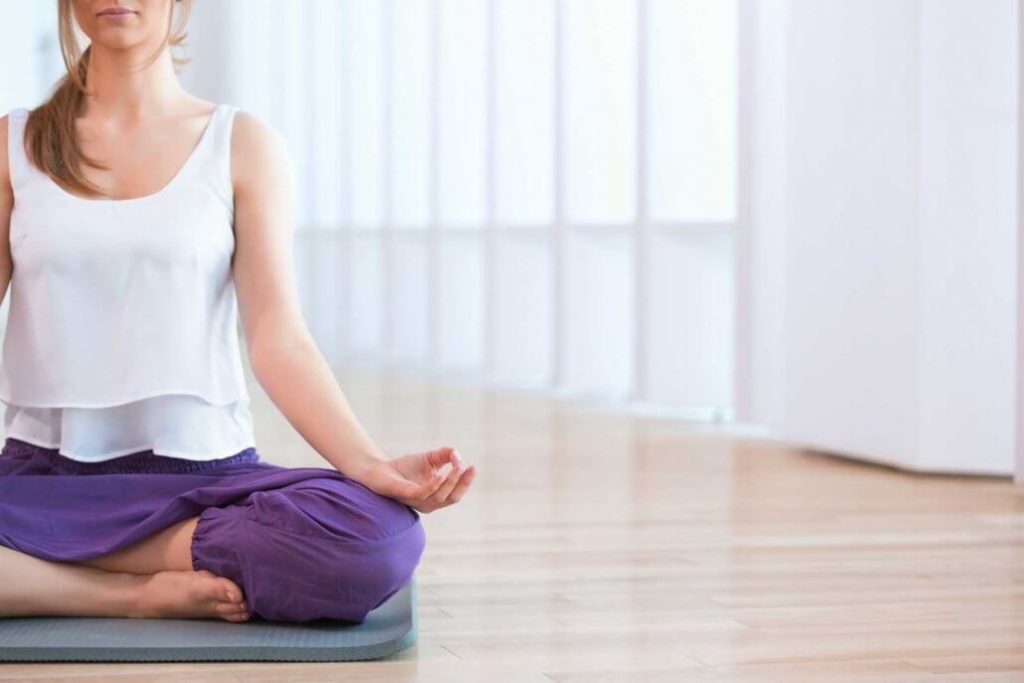
15. Fitness Apps and Online Resources: Enhancing Your Workout Experience
In the digital age, numerous fitness apps and online platforms offer a wide range of workouts, training plans, and resources. Here’s a guide to utilizing these tools effectively:
15.1 Fitness Apps:
Popular Apps:
- Nike Training Club: Offers a variety of workouts designed by trainers for various fitness levels.
- Fitbit Coach: Provides personalized workout routines and tracking features compatible with Fitbit devices.
- MyFitnessPal: Tracks nutrition, calories, and offers workout plans tailored to individual goals.
- Couch to 5K: Ideal for beginners, guiding users to run a 5K with a progressive training program.
Features:
- Workout Variety: Choose apps with diverse workouts like HIIT, yoga, strength training, etc.
- Personalization: Look for apps that adapt to your fitness level and goals for a tailored experience.
- Progress Tracking: Utilize apps that offer progress tracking, metrics, and goal setting for motivation.
15.2 Online Platforms:
YouTube Channels:
- FitnessBlender: Offers a variety of workout videos, including HIIT, strength, and flexibility routines.
- Yoga with Adriene: Provides yoga practices for different levels and focuses on mindfulness.
- Blogilates: Offers pilates and cardio workouts with a focus on motivation and community engagement.
Virtual Trainers:
- Online Personal Trainers: Consider virtual sessions with personal trainers for customized guidance.
- Live Workout Classes: Join live streaming workout sessions for real-time engagement and motivation.
15.3 Utilizing Resources:
Free vs. Paid Subscriptions:
- Explore Free Options: Many apps and platforms offer free workouts and trials before committing to paid subscriptions.
- Subscription Benefits: Paid subscriptions often unlock premium content, personalized plans, and ad-free experiences.
Community Engagement:
- Join Communities: Engage with online fitness communities, forums, or social media groups for motivation and support.
- Share Progress: Share your fitness journey and achievements to inspire others and stay accountable.
15.4 Tips for Effective Use:
- Experiment with Variety: Try different apps and platforms to find what suits your preferences and fitness goals.
- Consistency: Establish a regular workout routine and stick to it for consistent progress.
- Combine Resources: Combine different apps or platforms to access a wider range of workouts and training plans.
- Listen to Your Body: Pay attention to how your body responds to workouts and adapt accordingly.
- Stay Updated: Keep an eye out for new features, updates, or trends in the fitness tech world.
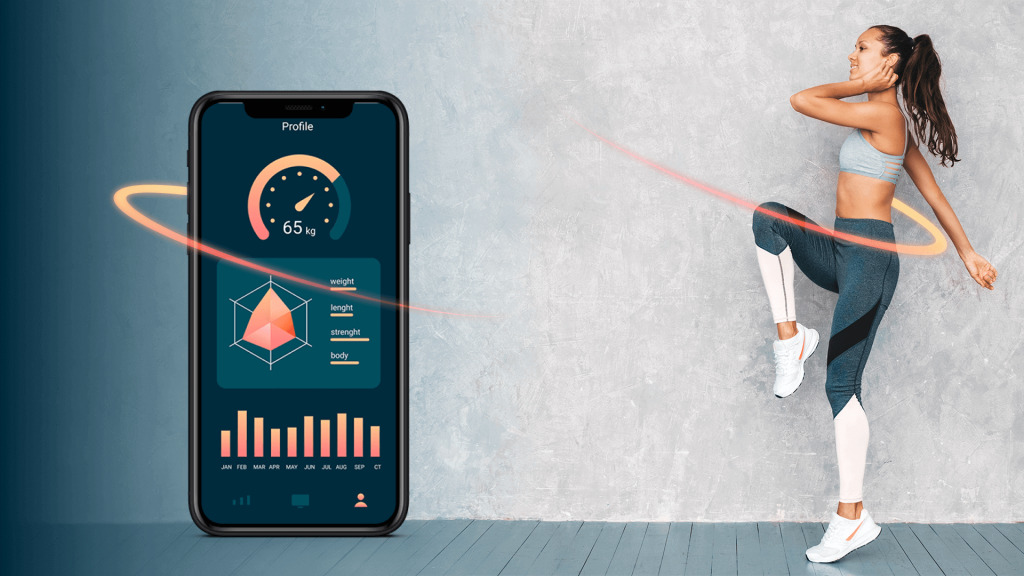
By incorporating these 15 free and convenient workouts into your routine, you can maintain your fitness levels and achieve your health goals without stepping outside your home.
Source: Admin compiled from the Internet



